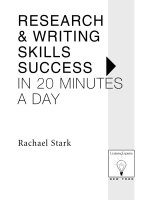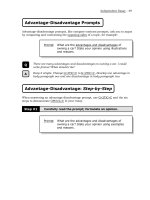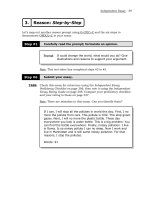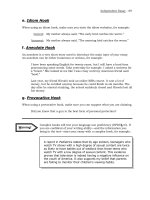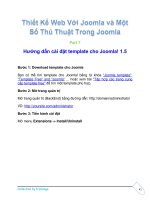Tài liệu RESEARCH AND WRITING SKILLS SUCCESS PART 7 doc
Bạn đang xem bản rút gọn của tài liệu. Xem và tải ngay bản đầy đủ của tài liệu tại đây (65.29 KB, 7 trang )
–
GETTING ESSENTIAL INFORMATION FROM ONLINE SOURCES
–
29
highly detailed information rather than the
broad base of generalized knowledge that you
can get from the websites listed previously.
Many times, university websites and private
collections provide abstracts or a summary of
articles on a particular topic as well as the
material itself. In addition, university websites
often include a reference number that allows
you to order the microfiche or printed version
of an article available in their collection.
Different Types of University
Search Engines
Like public libraries, many universities sub-
scribe to comprehensive search engines that
contain vast amounts of information. Several
of the most common search engines to which
universities frequently subscribe are:
■
EBSCOhost (www.EBSCO.com)—a large
database of full text articles with over
6,200 journals that are indexed and 5,000
journals in full text. Topics include the arts
and sciences, business, health, and news-
papers.
■
LexisNexis (www.LexisNexis.com)—a
search engine that offers full texts from
magazine and newspaper articles address-
ing general news, business, and legal
topics.
■
The Periodicals Contents Index
()—an index
that provides full texts from thousands of
journals in the humanities and social sci-
ences.
■
ProQuest Direct Index (http://ProQuest.
umi.com)—an index that provides full
texts of journals and newspapers on all
topics, including business.
In short, you should have no trouble
finding materials on your topic—no matter
what your topic or inquiry might be.
Remember, it always pays to ask a university or
institutional staff member for his or her help
and guidance. Each institution will have differ-
ent resources and procedures, but once again,
most staff members are eager to assist you and
provide you with any tips that they can.
Summary
Using the Internet is a quick and easy method
of gathering information. You can begin on
your own and get a lot of material by simply
typing your subject matter into one of the
search engines. The ten sites listed above
should provide you with a solid basis of
knowledge and sources. To obtain more spe-
cialized or in-depth materials, it often pays to
have privileges at a university or other cultural
institution. Try to make arrangements to do so
in advance so that you will have the most
diverse and unique sources available for your
work.
LESSON
31
LESSON
P
rimary sources are the most valuable sources of information for any topic or research
paper. Even though some of the primary resources you have collected may not seem espe-
cially valuable (they might be extremely dated, slightly damaged, or written from a very narrow
perspective), they are vital to your work. Primary sources, unlike secondary sources, offer you
■
an immediate perspective about an event that happened during the time period.
■
opinions that are candid and unique.
■
an opportunity for you to draw your own conclusions.
■
raw data that may not have been previously listed, collected, or compiled.
In some cases, you may also be the first person to review a primary source. For example, let’s
say that in your research, you had access to a recently found personal diary of President John F.
Kennedy that recounted the days and events before his assassination. Of course, this is highly
LESSON
Selecting the
Best Sources
LESSON SUMMARY
Now that you have collected information from a wide variety of
sources—books, magazine articles, reference texts, and the
Internet—how do you choose between them and evaluate what
you have? How can you tell which sources are the best for your
research paper without having to read through everything that
you’ve found? This lesson will show you what to look for in your
materials and how to make the most of what you have.
5
unlikely, but if it existed, it would reveal infor-
mation that was not included in previous his-
tories or biographies.
Other Primary Source
Materials
Unique primary sources that are often over-
looked can also include:
■
Personal diaries, chronicles, or notes from
a particular time period
■
Newspaper articles from a particular time
period
■
Physical, geographical, or topographical
maps
■
Official documents—such as the census or
other collections of statistics
■
Paintings, prints, drawings, and photo-
graphs
Although you may not typically think of
consulting such diverse sources, all of them are
excellent sources of information. Personal
diaries contain feelings of individuals and
might not be included in books. Newspaper
articles from a particular time period do not
have the benefit of hindsight and may include
key eyewitness accounts or testimonies of
events. Maps provide a physical portrait of a
specific place at a particular point in history, as
well as information about how people in the
past perceived the physical world. Official doc-
uments serve as legal statements of historical
events, people, and places. Any visual sources
—paintings, prints, drawings, and photo-
graphs—also capture a situation at a precise
moment and record it for posterity.
Becoming a Source Detective
Primary sources may be harder to locate than
other sources, but they are well worth it. The
beauty of working with primary sources—
once you’ve found them—is that you, as the
researcher, have to interpret them. You are not
reading a famous historian’s opinion of a situa-
tion; you are analyzing raw writing, visuals, and
data and coming to your own conclusions.
Sometimes, you will really feel like a detective
poring over information as you piece together
visuals of ancient historical sites or human
experiences from a distant past. Naturally, pri-
mary sources give your work and research an
authority and uniqueness that make your
paper stand out.
Other Tips for Selecting the
Best Sources
Mostly likely, in addition to your primary
sources, you should have many good second-
ary sources. Perhaps there are several books
that you found devoted to your topic, or
maybe there is a great deal written about your
topic in reference books or collections. If you
were researching the assassination of President
John F. Kennedy, there could be literally thou-
sands of books and articles on the topic. How
do you begin to pick and choose from all these
selections without spending the next five years
of your life reading? The first tip to follow
when researching secondary sources, partic-
ularly books, is to check two places immedi-
ately before you begin to read. These key or
strategic places to check are:
–
SELECTING THE BEST SOURCES
–
32
1.
the table of contents
2.
the index
The table of contents will immediately
tell you whether there is a chapter about your
topic, so you won’t have to read the entire
book in order to find the information you
need. If there is no table of contents, turn to
the back of the book and check the index for
an alphabetical list of topics. If your topic is
still not listed in the index, chances are that,
although the title or cover may be catchy, or
the book claims to talk about your topic, the
author cannot really provide you with key
information. If this is the case, don’t worry.
Two other strategic places to check for infor-
mation are:
3.
the bibliography
4.
footnotes or citations
Many times, even if an author does not
directly deal with your topic, it is a good idea
to turn to the back of the book and look at the
bibliography. What other books and titles did
this particular author consult? Are there any
that might be useful to you even though the
author doesn’t deal with them directly? In
addition, footnotes provide excellent clues.
Check the footnotes at the bottom of the pages
or at the end of a book. An author who uses a
lot of footnotes or documentation always has
to provide the source of the information and
the exact page it was found. In this way, even
though an entire book may not be helpful to
your work, you may get leads for other
sources.
Summary
Primary sources make any research paper vital
and exciting. They are always unique and pro-
vide you with the opportunity to draw your
own conclusions. Secondary sources are valu-
able, but always check key strategic places
before sitting down to read an entire book that
may or may not be valuable to your work. The
table of contents, index, bibliography, and
footnotes should specifically mention your
topic by name, give you precise chapters or
page numbers to consult, or list other helpful
books.
–
SELECTING THE BEST SOURCES
–
33
